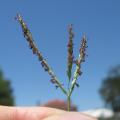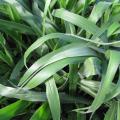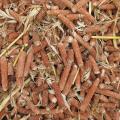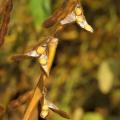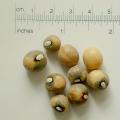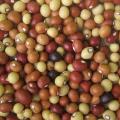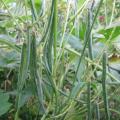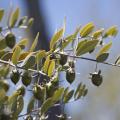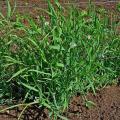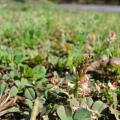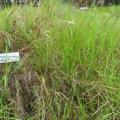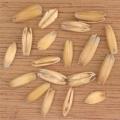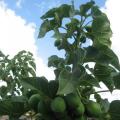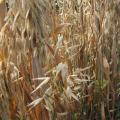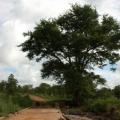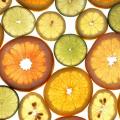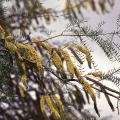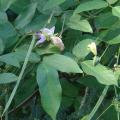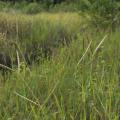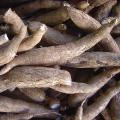Explore Feedipedia
|
Swazi grass (Digitaria swazilandensis Stent) is a tropical and subtropical grass... Read more |
Bread grass (Brachiaria brizantha (Hochst. ex A. Rich.) Stapf) is a tufted... Read more |
Maize cobs are a by-product of the maize crop, consisting of the central fibrous rachis... Read more |
|
The soybean (Glycine max (L.) Merr.) is an erect leguminous plant, up to 1 m... Read more |
The bambara groundnut (Vigna subterranea (L.) Verdc.) is an annual, creeping... Read more |
Bambara groundnut pods, shells and offal are the by-product of processing the seeds into... Read more |
|
Rice bean (Vigna umbellata (Thunb.) Ohwi & Ohashi) is a tropical to... Read more |
Jojoba (Simmondsia chinensis (Link) C. K. Schneid.) is a shrub native to... Read more |
Grass pea (Lathyrus sativus L.) is a dual purpose annual legume grown for its... Read more |
|
Crimson clover (Trifolium incarnatum L.) is an upright annual legume growing to... Read more |
Creeping indigo (Indigofera spicata Forssk. and Indigofera hendecaphylla... Read more |
Rhodes grass (Chloris gayana Kunth) is an important tropical grass widespread in... Read more |
|
Oats (Avena sativa L.) are a major cereal grain worldwide and the 6th... Read more |
Jatrophas are oil plants belonging to the Euphorbiaceae family. The Jatropha... Read more |
The oat plant (Avena sativa L.) is an annual grass grown primarily for its grain... Read more |
|
The monkey thorn (Acacia galpinii Burtt Davy) is a large deciduous tree of... Read more |
The citrus industry produce fruits that do not meet requirements for fresh products (up... Read more |
The Chilean mesquite (Prosopis chilensis (Molina) Stuntz) is a small to medium-... Read more |
|
Centro (Centrosema molle Mart. ex Benth.) is a vigorous twining, trailing and... Read more |
Centipede grass (Ischaemum timorense Kunth) is an annual or perennial spreading... Read more |
Cassava (Manihot esculenta Crantz) is a shrub grown in the tropics and... Read more |
Pages
Recent resources
 Opinion paper: Phasing out of the aid provided to the livestock sector during expectedly recurrent emergencies
- Makkar, 2024. animal
Opinion paper: Phasing out of the aid provided to the livestock sector during expectedly recurrent emergencies
- Makkar, 2024. animal
Open access opinion paper that makes a case that the emergency aid do more harm than good to African countries. It is valid for all the fields of agriculture but has direct consequence for animal agriculture. The context here is the aid provided during emergencies that are foreseeable recurrent.
The role of livestock in food security, poverty reduction and wealth creation in West Africa
- Molina-Flores et al., 2020. Food and Agriculture Organization of the United Nations Accra, 2020
Livestock is key to 377 million people in West Africa and in some countries, up to 60% of the population is involved in livestock production. The demand for animal products is increasing with population growth, urbanization, growing middle class, and due to shifting consumer preferences towards animal products. To meet this growing demand, countries in West Africa must engage in accelerated sustainable livestock production undertaking. Livestock development is key to eradicate hunger and poverty. This book attempts to provide up-to-date, and reliable information on the potentials, opportunities, and challenges of the livestock subsector in West Africa.
Pulses and their by-products as animal feed
- Sherasia et al., 2017. In: Calles, T.; Makkar, H. P. S. (Eds), FAO, Food and Agriculture Organization of the United Nations, Rome, Italy
This document provides a state-of-the-art review of the recent research (published and unpublished) on the use of pulses and their by-products as animal feed. It aims at raising awareness on the use of pulses and their by-products. It highlights the nutritional role of pulses and pulse by-products as animal feed and is a contribution to the legacy of the 2016 International Year of Pulses. This document will further enhance the use of these feed resources in other continents, besides Asia, where many pulse by-products are simply dumped. It is also expected that the synthesis presented contributes to make the use of pulses and their by-products as animal feed more efficient. This document will be useful for extension workers, researchers, feed industry, policy-makers and donors alike.









